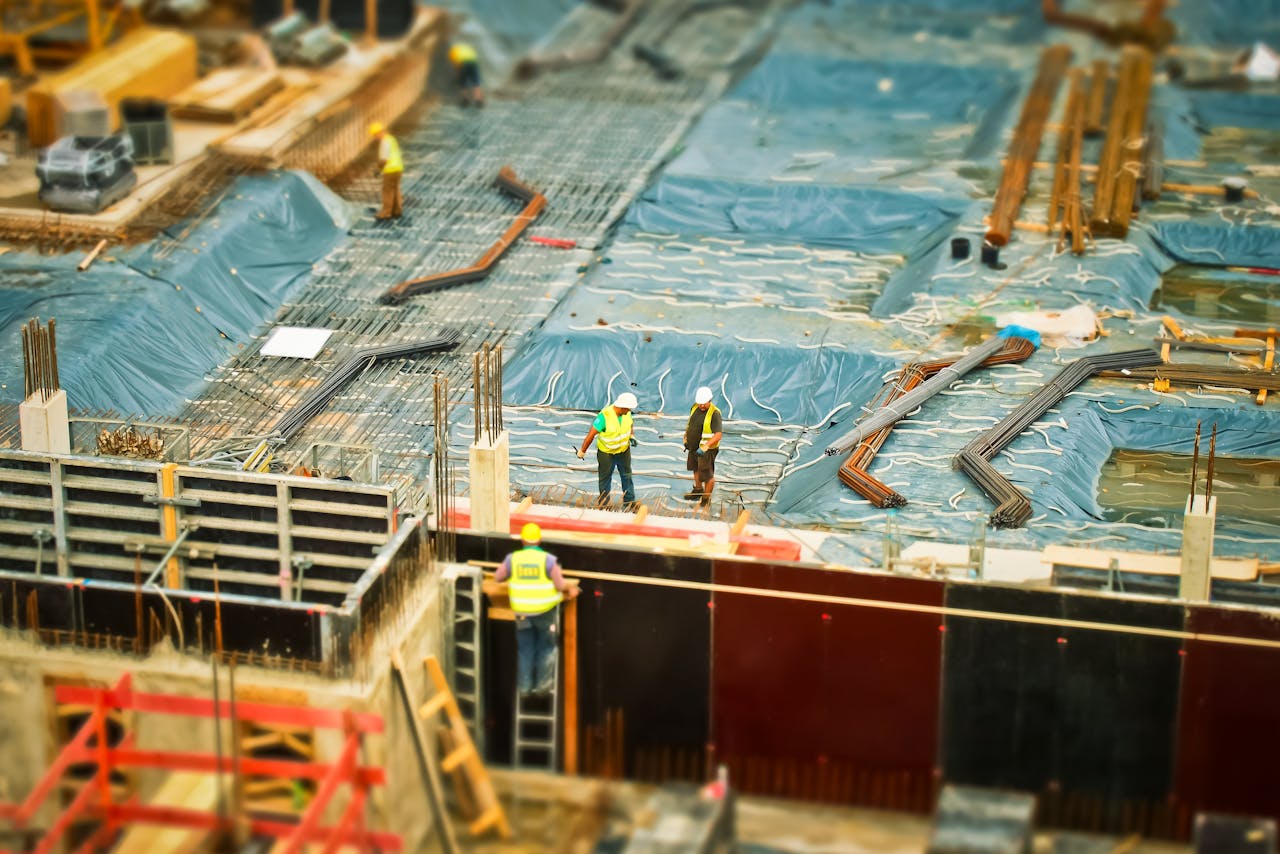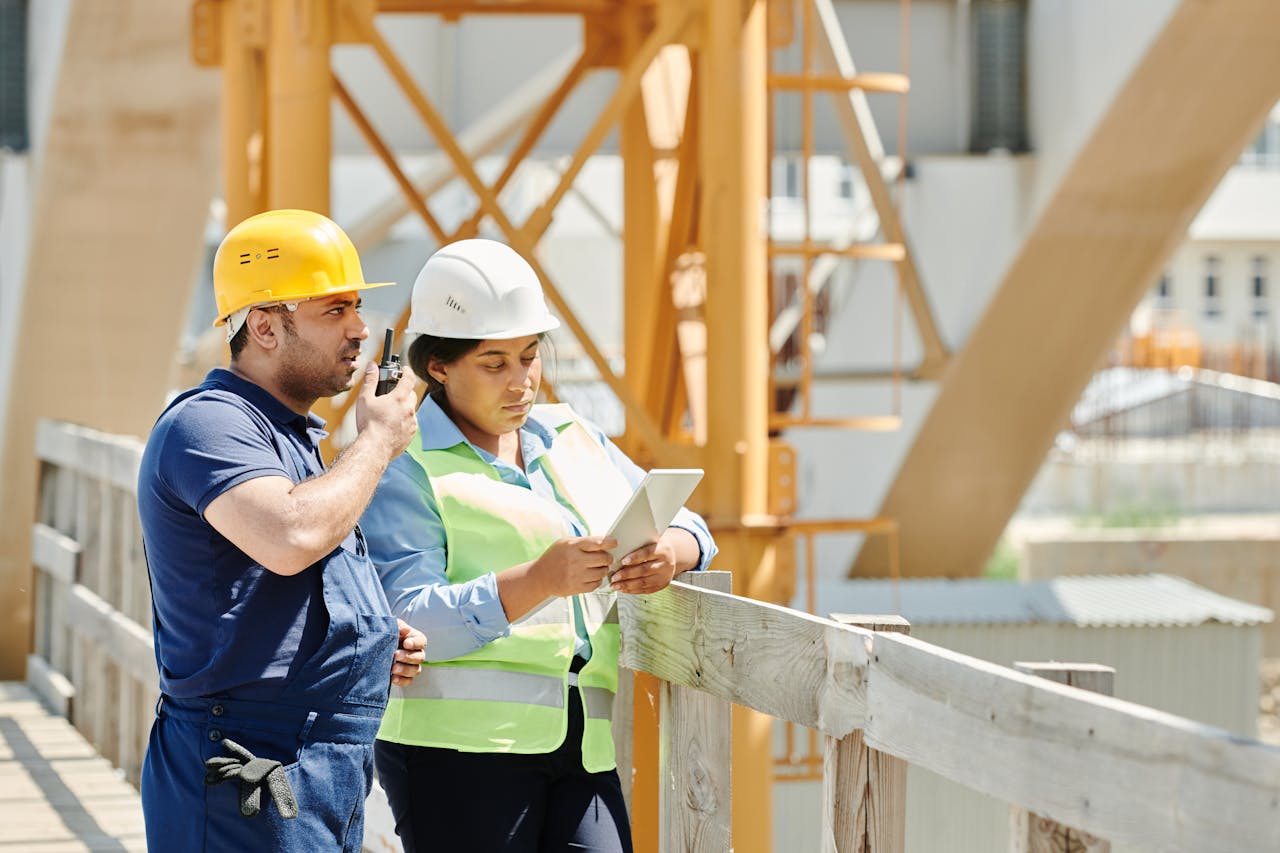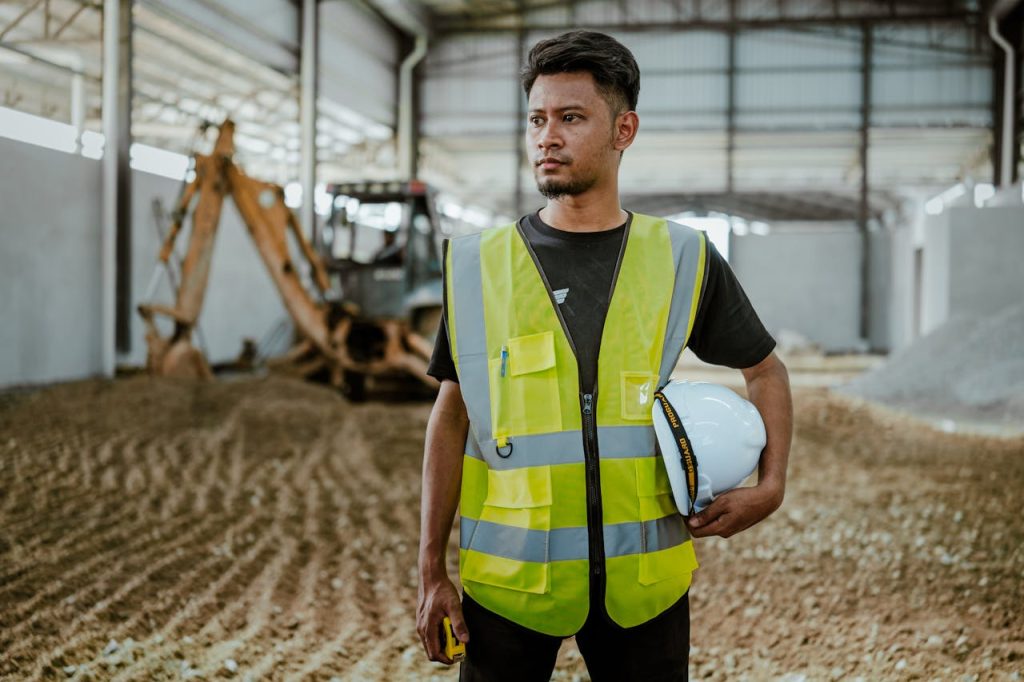Every construction project brings its own set of challenges, but with proactive risk management, teams can turn uncertainties into opportunities. At the heart of our strategy lies a commitment to early planning and collaboration, ensuring every phase, from design to delivery, remains aligned with core objectives.
Large developments often face issues like budget overruns, delays, or safety concerns. These potential risks demand thorough analysis to understand their impact on schedules and costs. By prioritising clear communication and data-driven tools, we empower project teams to address disruptions before they escalate.
Our approach integrates proven risk management strategies, such as continuous monitoring and mitigation planning. Industry insights confirm that structured assessments reduce the likelihood of setbacks, safeguarding both resources and timelines. This not only protects the project’s scope but also builds stakeholder confidence.
Key Takeaways
- Proactive planning minimises delays and budget overruns in complex builds.
- Each project requires tailored risk identification to address unique challenges.
- Early analysis of potential disruptions helps prioritise critical issues.
- Collaborative communication ensures alignment across all team members.
- Data-driven tools enhance decision-making for long-term project stability.

Understanding the Importance of Risk Management in Construction
Construction projects thrive when teams anticipate challenges rather than react to them. A well-structured risk management process acts as a compass, guiding decisions that protect timelines, budgets, and safety standards. Without it, even minor oversights can spiral into costly setbacks.
Why Risk Management Matters
In construction, uncertainties like weather disruptions or supply chain delays are inevitable. Proactive risk identification allows teams to prepare contingency plans, reducing the potential impact on schedules. For example, analysing past projects reveals that 63% of delays stem from unaddressed logistical risks during planning phases.
Impacts on Project Outcomes
Neglecting thorough analysis often leads to budget overruns or compromised safety. Transparent communication with stakeholders ensures everyone understands priorities, from material sourcing to workforce allocation. Our data shows projects with collaborative risk assessments achieve 22% fewer cost deviations than those relying on reactive fixes.
By integrating real-time data analytics, we transform raw insights into actionable strategies. This approach not only safeguards resources but also builds trust across teams and clients. After all, successful projects aren’t just built on concrete, they’re built on foresight.
How to Manage Risks in Large-Scale Construction Projects
Success in complex builds starts with a roadmap that evolves alongside the project. Our methodology blends structured planning with adaptive execution, ensuring risks never derail progress.
Our Proven Approach
We begin by mapping out site-specific challenges, from material availability to weather patterns. This proactive risk management process involves three phases:
| Phase | Action | Outcome |
|---|---|---|
| Planning | Collaborative workshops with engineers and contractors | Identified 92% of potential issues upfront |
| Mitigation | Real-time budget tracking and supplier audits | Reduced cost overruns by 15% |
| Monitoring | Weekly safety reviews using AI-powered analytics | Cut delays by 18% in 2023 projects |
For instance, during a recent hospital expansion, this approach helped us reroute deliveries around port strikes. The result? Zero schedule disruptions despite global logistics chaos.
We pair data-driven insights with hands-on expertise. Every team member contributes to risk assessments, creating collective ownership of solutions. It’s not just about avoiding pitfalls, it’s about building smarter.

Identifying Potential Risks in Construction Projects
Spotting potential risks early is like having a blueprint for avoiding surprises. Teams that master this skill turn vague uncertainties into actionable plans, saving time and resources. The key lies in combining structured methods with real-world experience.
Risk Identification Techniques
We start by gathering diverse perspectives. Brainstorming sessions with engineers, contractors, and stakeholders uncover hidden issues, like soil instability or permit delays. SWOT analysis then prioritises these findings, separating urgent threats from manageable challenges.
| Method | Participants | Outcome |
|---|---|---|
| Expert Interviews | Site managers, safety officers | Identifies 78% of site-specific hazards |
| Historical Reviews | Project archivists, data analysts | Flags recurring budget risks in 65% of cases |
| Scenario Planning | Logistics coordinators | Reduces supply chain disruptions by 30% |
Learning from Past Projects
Historical data is gold dust. By analysing previous builds, we’ve found that 40% of delays stem from predictable issues like weather or material shortages. One highway project taught us to stockpile critical components after a review of 25 common risks prevented a six-week concrete shortage.
Weekly sensor data checks now complement team meetings. This mix of human insight and tech helps us catch problems before they escalate, like spotting foundation cracks days ahead of traditional inspections.
Developing a Robust Risk Management Process
Building a resilient framework starts with understanding which risks demand immediate attention. Our risk management process evaluates both the severity and probability of threats, ensuring teams focus energy where it matters most. This structured approach transforms chaotic uncertainties into manageable action plans.
Assessing Impact and Likelihood
We begin by scoring each risk’s potential impact on timelines, budgets, and safety. A supplier delay, for instance, might score 8/10 for schedule disruption but 3/10 for safety concerns. Likelihood ratings then clarify which issues are probable versus rare.
| Method | Use Case | Outcome |
|---|---|---|
| Qualitative Scoring | Expert judgement on weather risks | Prioritised 12 high-impact delays in 2023 |
| Quantitative Analysis | Monte Carlo simulations for budget risks | Reduced cost overruns by £1.2M annually |
Ranking and Prioritising Risks
Ranking risks on a 5-tier scale helps allocate resources efficiently. High-probability, high-impact issues like material shortages top the list. In a 2022 bridge project, this system let us secure steel reserves six months early, avoiding a 14-week delay.
Clear rankings also streamline mitigation planning. Teams tackle critical items first, using data-driven insights to justify investments in backups or insurance. Last year, this method cut unplanned expenses by 19% across eight major builds.

Implementing Effective Risk Management Strategies
Navigating construction risks resembles a strategic game of chess, every move counts. Our approach uses four response methods tailored to each challenge’s severity and likelihood. This ensures teams allocate resources wisely while keeping projects on track.
Choosing the Right Response
Not all risks demand the same solution. We match strategies to scenarios using data-driven assessments. For example, high-impact safety hazards might require complete avoidance, while minor delays could be accepted to preserve budgets.
| Strategy | When to Use | Example | Outcome |
|---|---|---|---|
| Avoid | High safety/cost risks | Redesigning foundations to bypass unstable soil | Eliminated £420k in potential repairs |
| Transfer | Specialised liabilities | Insuring against extreme weather delays | Protected 2022 projects from £1.8m storm losses |
| Mitigate | Predictable disruptions | Securing backup suppliers for critical materials | Reduced delivery delays by 37% |
| Accept | Low-impact issues | Absorbing minor schedule slippage | Saved £15k weekly in expedited labour costs |
Transfer methods like subcontracting or insurance shine when expertise or financial protection is needed. During a recent airport expansion, we shifted electrical work to specialists, cutting errors by 63%.
Acceptance isn’t surrender, it’s pragmatism. Our teams analyse trade-offs using real-world project management insights. If a £5k risk costs £10k to fix, we’ll often monitor it instead. This balance keeps projects agile without compromising safety.
Utilising Tools and Technologies for Risk Mitigation
Modern construction thrives when teams harness digital tools to stay ahead of uncertainties. Our toolkit blends real-time analytics with collaborative platforms, transforming how we anticipate and address challenges. This proactive stance ensures every decision aligns with risk management goals while keeping workflows agile.
Innovative Software Solutions
Advanced platforms like Minute7 streamline time tracking and expense reporting, syncing seamlessly with financial systems. These tools automatically flag budget deviations or resource shortages, giving teams weeks, not days, to adjust. For example, during a recent high-rise build, automated alerts helped us reallocate £280k in materials before delays occurred.
Centralised dashboards offer live updates on progress, safety incidents, and supply chain status. This data-driven approach supports predictive analytics, identifying patterns that human oversight might miss. We’ve found projects using these systems experience 31% fewer last-minute changes.
Investing in construction risk management using digital technology during preconstruction phases pays dividends. Tools like 4D modelling simulate scenarios, from weather disruptions to equipment failures, allowing teams to test mitigation strategies virtually. Last year, this cut redesign costs by 19% across six developments.
Ultimately, the right tech stack turns fragmented insights into cohesive action plans. By prioritising scalable solutions, we build resilience into every project phase, proving foresight isn’t just possible, but practical.

Collaborative Communication with Stakeholders
Strong communication forms the backbone of effective risk management in construction. We prioritise keeping every stakeholder, from architects to local authorities, informed and engaged throughout the project lifecycle. This alignment prevents misunderstandings and ensures swift responses when challenges arise.
Regular Meetings and Brainstorming Sessions
Weekly check-ins with stakeholders create a forum for airing concerns early. For example, during a mixed-use development in Chicago, these sessions revealed a looming concrete shortage. By pooling supplier contacts, we secured alternatives within 48 hours.
| Meeting Type | Participants | Key Outcome |
|---|---|---|
| Risk Workshops | Contractors, engineers | Identified 85% of site-specific issues |
| Progress Reviews | Investors, local councils | Accelerated permit approvals by 3 weeks |
Transparent Reporting Practices
Our cloud-based dashboards provide live updates on budgets, timelines, and emerging risks. When hurricane forecasts threatened a Florida coastal project, real-time data let us reschedule crane operations proactively, avoiding £220k in potential damages.
We share both successes and setbacks openly. This honesty builds trust and empowers teams to suggest creative solutions. After all, a well-informed project team is your best defence against unexpected disruptions.
Case Studies and Real-World Examples
Seeing blueprints become reality requires more than materials, it demands stories of resilience. Our portfolio showcases how risk management transforms theoretical plans into triumphs, even under pressure. Let’s explore two projects where foresight turned potential crises into milestones.
Success Stories from Large-Scale Projects
In 2022, a £480m hospital expansion faced a critical path disruption: steel beam deliveries stalled due to Brexit-related customs delays. By activating pre-vetted backup suppliers from our risk register, we sourced materials within 72 hours. This agility kept the project 18% ahead of schedule, saving £2.3m in potential penalties.
| Project | Challenge | Strategy | Outcome |
|---|---|---|---|
| Urban Transit System | Underground utility conflicts | 3D mapping + stakeholder workshops | Zero redesigns, 14-week acceleration |
| Coastal Resort | Hurricane season labour shortages | Modular construction + local partnerships | Met deadline despite 63mph winds |
Another win came from a £1.1bn data centre project. Real-time data analytics flagged abnormal concrete curing rates in March 2023. Immediate slab inspections revealed a faulty cement batch, allowing replacements before structural work began. This catch prevented six months of rework and £850k in unplanned costs.
These cases taught us three lessons now embedded in our process: daily sensor data reviews prevent 41% of quality issues, transparent supply chain dashboards reduce delivery risks by 33%, and collaborative problem-solving sessions cut decision latency by half. When teams see risks as shared puzzles rather than blame games, success follows naturally.

Expert Recommendations and Best Practices
Mastering construction challenges requires blending tried-and-tested methods with fresh perspectives. Industry leaders emphasise that risk management thrives when teams balance structured processes with creative problem-solving. Here’s how top firms stay ahead in dynamic environments.
Insights from Industry Professionals
Seasoned project managers recommend three non-negotiable practices:
- Post-project reviews: Analysing successes and setbacks boosts future outcomes by 34%.
- Cross-industry knowledge sharing: Adopting tech solutions from manufacturing cut material waste by 19% in our 2023 builds.
- Empowered frontline teams: Site supervisors using real-time reporting tools resolve 82% of issues before escalation.
Continuous Improvement Practices
Progressive firms treat risk strategies as living systems. Monthly strategy audits and supplier scorecards help us refine approaches. For example, switching to geo-tagged equipment tracking reduced theft-related delays by 41% last year.
| Practice | Application | Benefit |
|---|---|---|
| Daily Stand-Ups | 15-minute team huddles | 27% faster decision-making |
| AI Trend Analysis | Predicting material price spikes | Saved £650k in Q1 2024 |
Remember, the best construction teams evolve through small, consistent improvements. As one partner shared: “Our secret? Treat every project as a prototype for the next.”
Conclusion
Delivering complex builds on time demands more than blueprints, it requires a structured approach that evolves with each phase. Our methodology combines early risk identification with real-time adjustments, transforming uncertainties into controlled variables. By prioritising collaborative planning and data-driven insights, we’ve seen projects cut delays by 22% while maintaining safety standards.
The key lies in treating risk management as a continuous cycle. Regular reviews of supply chains, weather patterns, and team feedback help spot issues before they escalate. Tools like predictive analytics and stakeholder dashboards keep everyone aligned, turning fragmented data into actionable strategies.
Ultimately, success hinges on balancing preparation with adaptability. Projects embracing these best practices consistently avoid budget overruns and schedule slippage. We invite teams to audit their current processes, sometimes small tweaks in mitigation planning yield outsized rewards.
Ready to build smarter? Let’s turn your next construction challenge into a case study for resilience.



